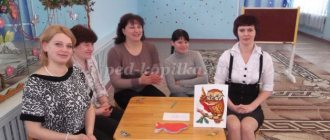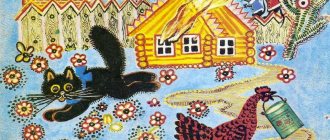MAGAZINE Preschooler.RF
Designing the dramatization game “Zayushkina’s Hut” in the preparatory groupMethodological development
Compiled by:
- educators Ignatova L.A.
- Krymova I.Yu.
g.o. Serpukhov 2022 Municipal preschool educational institution combined type kindergarten No. 29 “Bee”
Introduction
“The theater is a magical world. He gives lessons of beauty, morality and ethics. And the richer they are, the more successful the development of the spiritual world of children is...” (B. M. Teplov)
Each of us spends our childhood in the world of role-playing games, which help the child master the rules and laws of adults. Games for children can be considered as improvised theatrical performances in which the doll or the child himself has his own things, toys, furniture, clothes, etc. The child is given the opportunity to play the role of an actor, director, decorator, prop maker, and musician. Each child plays differently, but they all copy adults in their games. Based on games and how children play them, we can imagine our future society.
Theatrical activities in kindergarten are a good opportunity to reveal the creative potential of the child and nurture the creative orientation of the individual. Children learn to notice interesting ideas in the world around them, embody them, create their own artistic image of a character, they develop creative imagination, associative thinking, and the ability to see unusual moments in the ordinary.
In addition, collective theatrical activities are aimed at a holistic impact on the child’s personality, his emancipation, involvement in action, while activating all his capabilities; for independent creativity; development of all leading mental processes; promotes self-knowledge and self-expression of the individual with a fairly high degree of freedom; creates conditions for the socialization of the child, while strengthening his adaptive abilities, corrects communication deviations; helps to realize the feelings of satisfaction, joy, significance that arise as a result of identifying hidden talents and potentials.
Theater is one of the most democratic and accessible forms of art for children; it allows you to solve many pressing problems of modern pedagogy and psychology related to:
- art education and raising children, the formation of aesthetic taste, moral education, the development of communicative qualities of the individual (training in verbal and non-verbal types of communication)
- education of will, development of memory, imagination, initiative, fantasy, speech (dialogue and monologue)
- creating a positive emotional mood, relieving tension, resolving conflict situations through play.
Relevance of the topic. “Children have stopped reading” - we hear this phrase very often. TV, videos, and computer games consume a child’s time and capture the reserved corners of his consciousness and soul. But a book cannot be replaced by a screen. “Reading books is the path along which a skillful, intelligent, thinking teacher finds the way to a child’s heart . V.A. Sukhomlinsky. Books with fairy tales introduce a child to the world of human feelings, joy and suffering, relationships, actions, characters. The role of fairy tales in the formation of a child’s personality and speech development is great.
A fairy tale is a complex and important element of culture for children's development. Folk tales not only enrich a child’s imagination, but also contribute to the development of creative activity. However, in order to promote effective child development, you need to be able to introduce a child to a fairy tale. It is not enough to simply read a story, ask some questions and move on to the next one. It is important for preschoolers to create “fairy-tale” developmental environment in which the child will live, play, create and love fairy tales.
A fairy tale occupies a special place in a child’s life. And a fairy tale told by the child himself remains in the children’s memory for a long time. Children like to dramatize scenes from fairy tales using characters from different types of theater (on sticks, tabletop, cone, finger and others).
Goal: development of children's creative abilities, compassion and mutual assistance; strengthening dramatization skills, increasing interest in productive activities; instilling in children a desire to participate in dramatizations of familiar fairy tales.
Tasks:
- arouse interest in theatrical play activities
- create a sense of success for each individual child
- continue to introduce theatrical terminology
- improve the ability to tell a fairy tale by role, teach, convey the mood of the characters with intonation
- cultivate a sense of empathy, a desire to help, friendly relations in the game, a sense of responsibility to the team.
Main part. Game - dramatization
Section 1. Stages of working on a dramatization game
1. 1. Management of games - dramatizations
No aspect of pedagogical work causes as many difficulties for a teacher as directing children's games. They sometimes arise due to a one-sided understanding of the role of the game, an exaggeration of its didactic significance and an underestimation of its influence on the upbringing of children. This applies to dramatization games
The dramatization game is a unique and independently existing type of play activity. It differs from ordinary plot-role-playing activities in that it is created according to a ready-made plot taken from a book. The game plan and sequences of actions are determined in advance. Such a game is more difficult for children than imitating what they see in life: it is necessary to imagine the images of the heroes, their behavior, to remember well the course of the action, and a certain supply of knowledge, abilities, and skills is required, therefore this type of play activity acquires a developed character only in older children. preschool age.
With the focused guidance of the teacher, these games are of great importance. They enrich children with impressions, cultivate interest and love for literature and their native word. Participation in a dramatization provides participants with a wide scope for showing initiative and creativity, since game actions should be created, embodied in some movements, facial expressions, intonations - after all, they are not given in a finished form in the work. The child needs to imagine himself in the place of the character being portrayed, to penetrate his feelings and experiences in order to convey the appropriate image. Discussion of events, actions, characters of characters in combination with the search for events, characters, methods of conveying an image eliminates the feeling of empathy, encourages children to look closely at the world around them, teach them to distinguish between good and evil in human relations, i.e. actively contributes to the formation of personality, the formation The child has high moral standards and assessments.
The teacher’s guidance of children’s games should be aimed at developing their abilities, teaching them the skills and abilities necessary for this activity.
When selecting literary works for dramatization games, it is necessary to take into account that preschool children are, first of all, attracted by a dynamic and entertaining plot, the presence of dialogues, short monologues, and vivid artistic language. The works should be close to children in content and easy to implement; it is important that they express transitions from one event to another, so that the characters are endowed with active actions.
Preschoolers especially love folk tales. They are characterized by dramatic conflict, acute situations, emotional intensity, short and expressive dialogues, simplicity and figurative language. Children of senior preschool age dramatize fairy tales with great pleasure ." In our group, we decided to dramatize the Russian folk tale “Zayushkina’s Hut” . The choice of this fairy tale was due to the fact that the social and communicative qualities of children in the group were not sufficiently expressed.
All preparatory work to introduce children to dramatization should be carried out in stages.
| Next > |



